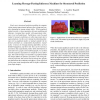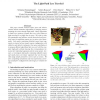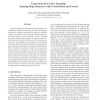CVPR
2011
IEEE
14 years 3 months ago
2011
IEEE
This paper addresses the problem of 3D motion reconstruction from a series of 2D projections under low reconstructibility. Reconstructibility defines the accuracy of a 3D reconst...
CVPR
2011
IEEE
14 years 3 months ago
2011
IEEE
Nearly every structured prediction problem in computer vision requires approximate inference due to large and complex dependencies among output labels. While graphical models prov...
389
click to vote
CVPR
2011
IEEE
14 years 3 months ago
2011
IEEE
This paper extends classical object pose and relative camera motion estimation algorithms for imaging sensors sampling the scene through light-paths. Many algorithms in multi-view...
CVPR
2011
IEEE
14 years 3 months ago
2011
IEEE
Color is known to be highly discriminative for many object recognition tasks, but is difficult to infer from uncontrolled images in which the illuminant is not known. Traditional...
CVPR
2011
IEEE
14 years 3 months ago
2011
IEEE
In this paper we explore the idea of using high-level semantic concepts, also called attributes, to represent human actions from videos and argue that attributes enable the constr...
CVPR
2011
IEEE
14 years 3 months ago
2011
IEEE
Active learning and crowdsourcing are promising ways to efficiently build up training sets for object recognition, but thus far techniques are tested in artificially controlled ...
CVPR
2011
IEEE
14 years 3 months ago
2011
IEEE
We present a human-centric paradigm for scene understanding. Our approach goes beyond estimating 3D scene geometry and predicts the “workspace” of a human which is represented...
CVPR
2011
IEEE
14 years 3 months ago
2011
IEEE
We propose a dense local region detector to extract features suitable for image matching and object recognition tasks. Whereas traditional local interest operators rely on repeata...
CVPR
2011
IEEE
14 years 3 months ago
2011
IEEE
In this paper, we present a novel approach to recognizing human actions from different views by view knowledge transfer. An action is originally modelled as a bag of visual-words ...
CVPR
2011
IEEE
14 years 3 months ago
2011
IEEE
Training of conditional random fields often takes the form of a double-loop procedure with message-passing inference in the inner loop. This can be very expensive, as the need to...



